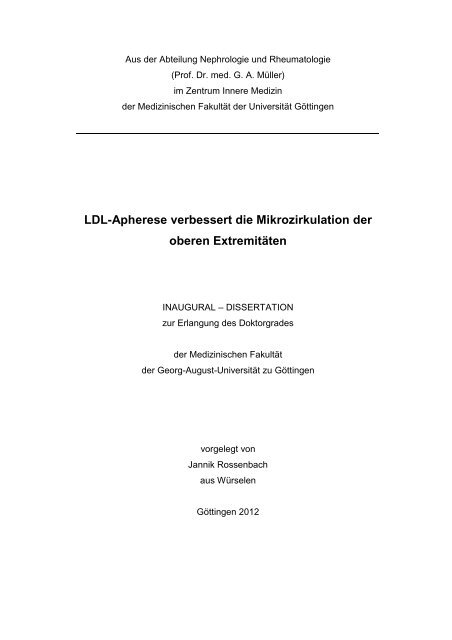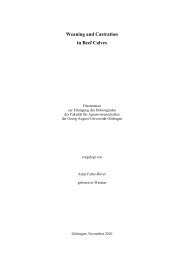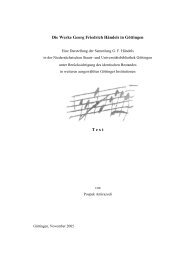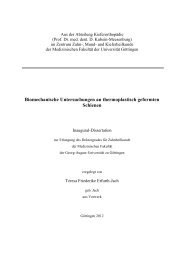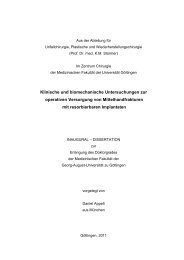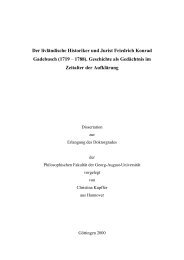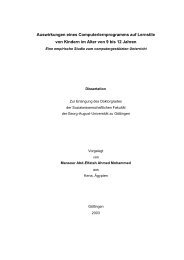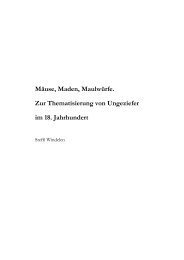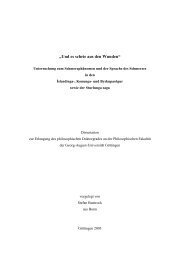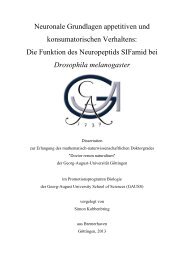Öffnen - eDiss
Öffnen - eDiss
Öffnen - eDiss
Erfolgreiche ePaper selbst erstellen
Machen Sie aus Ihren PDF Publikationen ein blätterbares Flipbook mit unserer einzigartigen Google optimierten e-Paper Software.
Aus der Abteilung Nephrologie und Rheumatologie<br />
(Prof. Dr. med. G. A. Müller)<br />
im Zentrum Innere Medizin<br />
der Medizinischen Fakultät der Universität Göttingen<br />
LDL-Apherese verbessert die Mikrozirkulation der<br />
oberen Extremitäten<br />
INAUGURAL – DISSERTATION<br />
zur Erlangung des Doktorgrades<br />
der Medizinischen Fakultät<br />
der Georg-August-Universität zu Göttingen<br />
vorgelegt von<br />
Jannik Rossenbach<br />
aus Würselen<br />
Göttingen 2012
D e k a n: Prof. Dr. med. C. Frömmel<br />
I. Berichterstatter: Priv.-Doz. Dr. med. M. Koziolek<br />
II. Berichterstatter/in: Priv.-Doz. Dr. med. J. Riggert<br />
III. Berichterstatter/in: Prof. Dr. med. Dr. rer. nat. Th. Crozier<br />
Tag der mündlichen Prüfung: 05. März 2012
Diese Schrift gründet sich auf folgende Originalarbeit:<br />
Rossenbach J, Mueller G A, Lange K, Armstrong VW † , Schmitto JD,<br />
Hintze E, Helfmann J, Konstantinides S, Koziolek MJ (2011):<br />
Lipid-Apheresis improves microcirculation of the upper limbs.<br />
J Clin Apher 10.1002<br />
Impact factor: 1,838
INHALTSVERZEICHNIS<br />
1. Inhalt der Publikation und innerer Zusammenhang<br />
Seitenzahl<br />
1.1. Einleitung 1-4<br />
1.1.1. Apherese–Therapieverfahren<br />
1.1.2. Pathomechanismus<br />
1.1.3. Stand der Forschung<br />
1.1.4. Studienziele<br />
1.2. Methodik 5-7<br />
1.2.1. Kapillarmikroskopie<br />
1.2.2. Photoplethysmographie<br />
1.2.3. Dopplerverschlussdruckmessung<br />
durch pneumatisch segmentale Pulsoszillographie<br />
1.2.4. Laser-Doppler-Anemometrie (LDA)<br />
1.2.5. Blutanalysen<br />
1.3. Ergebnisse 8-14<br />
1.3.1. Kapillarmikroskopie<br />
1.3.2. Photoplethysmographie<br />
1.3.3. Dopplerverschlussdruckmessung<br />
durch pneumatisch segmentale Pulsoszillographie<br />
1.3.4. Laser-Doppler-Anemometrie (LDA)<br />
1.3.5. Blutanalysen<br />
1.3.6. Diskussion<br />
1.4. Literaturzitate, die über die Publikation hinausgehen 15-16<br />
2. Publikation 17<br />
Rossenbach J, Mueller G A, Lange K, Armstrong VW † , Schmitto<br />
JD, Hintze E, Helfmann J, Konstantinides S, Koziolek MJ (2011):<br />
Lipid-Apheresis improves microcirculation of the upper limbs.<br />
J Clin Apher 10.1002
1. Inhalt der Publikation und innerer Zusammenhang<br />
1.1. Einleitung<br />
Eine große Anzahl von Patienten leidet an einer Hypercholesterinämie.<br />
Diese stellt einen entscheidenden Risikofaktor für das Entstehen von<br />
atherosklerotischen Veränderungen dar, die Prädiktoren für das Auftreten<br />
von kardiovaskulären Erkrankungen, wie koronare Herzkrankheit (KHK),<br />
neurovaskuläre Ereignisse oder periphere arterielle Verschlusskrankheit<br />
(pAVK), sind (Rubba 12 * et al. 1990; Nishimura 26 et al. 1999; Mellwig 1 et al.<br />
2006; Morimoto 31 et al. 2007).<br />
Bei der schweren, oft erblichen Form der familiären Hypercholesterinämie<br />
(FH) können trotz maximaler diätetischer und medikamentöser Therapie<br />
die Zielwerte für LDL-Cholesterin (LDL-C) nicht erreicht werden<br />
(Thompson 8 et al. 1980; Nishimura 26 et al. 1999).<br />
Eine weitergehende Absenkung des LDL-C ist bei der FH nur mit der LDL-<br />
Apherese (LDL-A) möglich (Rubba 12 et al. 1990). Hierbei werden pro-<br />
atherosklerotischen LDL-C und Lipoprotein a (Lp(a)) aus dem Blut entfernt<br />
(Tsuchida 7 et al. 2006), darüber hinaus wird die Durchblutung von<br />
weiteren Faktoren, die bei der LDL-A verändert werden, beeinflusst.<br />
1.1.1. Apherese – Therapieverfahren<br />
Als Verfahren zur extrakorporalen LDL-Elimination werden im Zentrum der<br />
Universität Göttingen eingesetzt:<br />
• Direkte Adsorption von Lipoproteinen aus Vollblut (Polyacrylate full<br />
blood absorption (PFBA), (DALI ® , Fa. Fresenius AG))<br />
• Heparinpräzipitation (heparininduzierte extrakorporale LDL-<br />
Präzipitation (H.E.L.P.), (H. E. L. P. ® , Fa. B. Braun Melsungen AG))<br />
• Membrandifferentialfiltration (double filtration plasmapheresis (DFPP),<br />
(Thermofiltration ® , Fa. Diamed GmbH))<br />
* Autoren, die nur im Literaturverzeichnis der Publikation aufgeführt sind, werden hier mit<br />
hochgestellter Ordnungszahl zitiert, unter der sie im Literaturverzeichnis der Publikation auf Seite<br />
6/7 erscheinen.<br />
1
Die drei genannten Therapieverfahren werden jetzt im Einzelnen kurz<br />
vorgestellt:<br />
Bei der direkten Adsorption aus Vollblut (DALI ® ) werden apoB-tragende<br />
Lipoproteine mittels kovalenter Bindung an polyanionisches Polyacrylamid<br />
aus dem Vollblut gefiltert. Das „gereinigte“ Vollblut wird dem Patienten re-<br />
infundiert (Bosch 2004).<br />
Bei der H.E.L.P.-Therapie wird zuerst eine Plasmaseparation<br />
vorgenommen. Das so gewonnene Plasma wird mit einer sauren<br />
Heparinlösung versetzt. Hierdurch bilden sich Komplexe aus Heparin mit<br />
Apolipoprotein-B-haltigen Lipiden, Fibrinogen und anderen rheologisch<br />
bedeutsamen Proteinen, wie Fibronektin. Diese so gebildeten Komplexe<br />
fallen aus und werden mit einem Polykarbonatfilter herausgefiltert. Das<br />
überschüssige Heparin wird anschließend chemisch aus dem Plasma<br />
entfernt. Im heparin- und nahezu cholesterinfreien Plasma wird<br />
anschließend das physiologische Plasmamilieu durch eine<br />
Bikarbonatdialyse wiederhergestellt und überschüssige Flüssigkeit<br />
entfernt. Das Plasma wird zusammen mit den korpuskulären<br />
Blutbestandteilen dem Patienten wieder reinfundiert (Bosch 2005).<br />
Bei der Membrandifferentialfiltration (Thermofiltration ® ) wird das Plasma<br />
nach der Plasmaseparation durch einen zweiten Plasmafilter gepresst,<br />
dessen Porengröße genau definiert ist und geringfügig unter der<br />
Molekülgröße des LDL-C liegt. Dieses wird durch den Filter mechanisch<br />
zurückgehalten. Das LDL-C freie Plasma wird dann dem Patienten<br />
reinfundiert. Zusätzlich werden auch andere größere Moleküle wie Lp(a)<br />
abgefiltert (Klingel et al. 2004).<br />
1.1.2. Pathomechanismus<br />
Sowohl bei der Entstehung der Atherosklerose als auch für deren<br />
Progression spielt die Dysfunktion der Endothelien die entscheidende<br />
Rolle. Obwohl der Pathomechanismus der endothelialen Dysfunktion noch<br />
2
nicht in allen Einzelheiten bekannt ist, kommt der Interaktion zwischen<br />
LDL-C mit dem in den Endothelzellen synthetisierten Stickstoffmonoxid<br />
(NO) große Bedeutung zu. Bei hohen LDL-C Konzentrationen im Blut<br />
akkumuliert dieses im subendothelialen Raum (zwischen Intima und<br />
Media) und wird dort oxidiert und enzymatisch modifiziert. Dieses<br />
modifizierte LDL-C bewirkt eine Inaktivierung von NO (Mellwig et al.<br />
2003), da es zum einen die rezeptor-vermittelte Freisetzung von NO<br />
supprimiert und zum anderen die endotheliale NO-Syntethase direkt<br />
hemmt (Mellwig et al. 2003). Daraus resultiert eine Hemmung der<br />
rezeptor- und strömungsvermittelten endothel- abhängigen Vasodilatation.<br />
Modifiziertes LDL-C hat aber noch weitere Einflüsse, z.B. die Wirkung auf<br />
Fibroblasten, Makrophagen, bei denen die Inflammationsreaktion zu<br />
einem Matrixumbau führt und die Entstehung der Plaques voranschreitet,<br />
sowie die direkte Wirkung auf das Endothel (Nishimura 26 et al. 1999;<br />
Mellwig et al. 2003).<br />
1.1.3. Stand der Forschung<br />
Zahlreiche Studien konnten die Wirksamkeit der LDL-A auf den Endpunkt<br />
kardiovaskuläres Ereignis (Tod, Myokardinfarkt, Apoplex, Amputation<br />
einer Extremität) nachweisen (Ramunni et al. 2003; Schuff-Werner 2003;<br />
Krebs et al. 2004; Sachais 6 et al. 2005). In einer an der<br />
Universitätsmedizin Göttingen durchgeführten retrospektiven Analyse<br />
(Koziolek 5 et al. 2010) konnte die protektive Wirkung der Langzeit-LDL-A<br />
bei einem Beobachtungszeitraum von bis zu 20 Jahre bestätigen werden.<br />
Die Effizienz der LDL-A scheint jedoch nicht nur auf der Absenkung der<br />
pro-atherogenen Lipoproteine LDL-C und des Lp(a) zu beruhen. In<br />
verschiedenen Studien konnten absenkende Effekte auf die Konzentration<br />
pro-inflammatorischer Zytokine und Mediatoren, rheologisch bedeutsamer<br />
Proteine sowie Wachstumsfaktoren beobachtet werden (Bosch und Keller<br />
2003; Dihazi 17 et al. 2008). Durch in-vitro-Testungen konnten positive<br />
Effekte auf die Plasmaviskosität und Erythrozytenaggregation<br />
nachgewiesen werden (Otto et al. 2004). Die Verbesserung der<br />
rheologischen Eigenschaften werden auch bei anderen Indikationen<br />
3
genutzt, wie beispielsweise bei der Behandlung der Makuladegeneration<br />
oder des Hörsturzes (Mösges et al. 2009). Insgesamt resultiert eine<br />
Verbesserung der Endstromversorgung (Mellwig et al. 2003; Matschke 28<br />
et al. 2004).<br />
Es scheinen jedoch auch Faktoren durch die LDL-A beeinflusst zu<br />
werden, die den Gefäßtonus regulieren können. Dazu zählen Bradykinin,<br />
Endothelin (ET-1) und NO (Kobayashi et al. 2004; Wang et al. 2004). Für<br />
andere Mediatoren, die u.a. bei Hypercholesterinämie erhöht sind, wie<br />
z.B. das asymmetrische Dimethylarginin (ADMA), gibt es bisher keine<br />
Daten. Ob Änderungen dieser Mediatoren durch die LDL-A auch in vivo zu<br />
einer Änderung des Gefäßtonus und der Gefäßreagibilität führen, und<br />
damit zu einer Verbesserung der arteriellen und kapillären Durchblutung<br />
beitragen, ist bis dato nicht belegt.<br />
1.1.4. Studienziele<br />
Ziel der Studie war es, den Einfluss der LDL-A auf die arterielle/arterioläre<br />
und kapilläre Durchblutungssituation in vivo zu testen.<br />
Dazu wurden folgende Aspekte näher untersucht:<br />
• Verbesserung der Endstromversorgung durch die LDL-A mittels<br />
Kapillarmikroskopie und Laser-Doppler-Anemometrie (LDA)<br />
• Beeinflussung der arteriolären und kapillären Gefäßweite durch die LDL-<br />
A mittels Kapillarmikroskopie<br />
• Beeinflussung des arteriolären und kapillären Blutflusses durch die LDL-<br />
A mittels Kapillarmikroskopie und LDA<br />
• Beeinflussung der Gefäßreagibilität durch die LDL-A mittels<br />
Photoplethysmographie<br />
• Beeinflussung der Konzentration vasokonstriktorischer und<br />
vasodilatatorischer Mediatoren durch die LDL-A mittels Blutanalysen<br />
• Unterschiede zwischen den verwendeten LDL-Aphereseverfahren in<br />
Bezug auf die untersuchten Effekte.<br />
4
1.2. Methodik<br />
Es wurden 22 Patienten, die sich einmal wöchentlich einer LDL-A<br />
Behandlung auf der Apheresestation der Universitätsmedizin Göttingen<br />
unterziehen, vor [Anfang Prozedere (AP)] und nach [Ende Prozedere<br />
(EP)] LDL-A untersucht. Zur Charakterisierung des Patientenkollektives<br />
siehe auch Rossenbach et al. 2011, Seite 4, Tabelle I.<br />
Die Studie wurde von der Ethikkommission der Universität Göttingen<br />
genehmigt (Studienprotokoll Nummer 40/12/05). Alle Patienten haben ihr<br />
schriftliches Einverständnis gegeben. Im Fall von Minderjährigen gaben<br />
dies die Eltern.<br />
1.2.1. Kapillarmikroskopie<br />
Mit der Kapillarmikroskopie wurde die Nagelfalz der Fingern II-V beider<br />
Hände mit einem Auflichtmikroskop (SMZ-U, Nikon, Japan) in 20-facher<br />
Vergrößerung untersucht. Hier wurden in vivo der Blutfluss, die<br />
Vasomotorik und die Erythrozytenaggregation beurteilt.<br />
Die Datenerhebung erfolgte mittels semiquantitativer Scores: Erhoben<br />
wurden der Blutfluss von (+) bis (+++) (+ = verlangsamt, ++ = normal und<br />
+++ = beschleunigt), die Vasomotorik von (0) bis (++++) (0 = keine<br />
Kapillarfüllung, + = selten gefüllt/kurz sichtbar, ++ = öfter gefüllt/länger<br />
sichtbar, +++ = kurze Unterbrechung, ++++ = dauerhafte Füllung) und die<br />
Erythrozytenaggregationsneigung von (0) bis (++++) (0 = starke<br />
Aggregationsneigung/zerbröckelnde Blutsäule, + = mäßige Aggregation,<br />
++ = leichte Aggregation, +++ = leichte und seltene Aggregation, ++++ =<br />
schnelle Zirkulation ohne Aggregation).<br />
1.2.2. Photoplethysmographie<br />
Die Messungen der Photoplethysmographie (Vasoqunt VQ4000, ELCAT<br />
medical systems, Germany) wurden ebenfalls unmittelbar vor und nach<br />
Therapie durchgeführt. Mit diesem Verfahren wurden jeweils unter<br />
Ruhebedingungen, Kälte- und Wärmestress Blutfluss und Reagibilität der<br />
5
Gefäße beurteilt. Zur Beschreibung des Versuchsablaufes, sowie<br />
Berechnung des Blutflusses und der Gefäßreagibilität siehe Rossenbach<br />
et al. 2011, Seite 2.<br />
1.2.3. Dopplerverschlussdruckmessung durch pneumatisch<br />
segmentale Pulsoszillographie<br />
Der arterielle Verschlussdruck wurde mit dem OXFORD sonicaid 421<br />
durchgeführt. Hier erfolgte die Messung ebenfalls AP und EP. Gemessen<br />
wurden die A. brachialis, A. radialis und A. ulnaris. Bei Patienten mit Shunt<br />
wurde die betreffende Seite ausgelassen.<br />
1.2.4. Laser-Doppler-Anemometrie (LDA)<br />
Die LDA wurde von der Laser- und Medizin-Technologie GmbH entwickelt<br />
und ist ein optisches Verfahren zur Messung von<br />
Strömungsgeschwindigkeiten des Blutflusses der oberen Hautschichten.<br />
Bei diesem gemessenen Blutfluss handelt es sich um einen relativen<br />
Blutfluss, da das gestreute Licht noch mit einem zweiten Lichtstrahl als<br />
Referenz überlagert wird. Das Verfahren beruht auf der Messung der<br />
Dopplerverschiebung von in der Haut an Blutkörperchen gestreutem<br />
Laser-Licht und Berechnung eines relativen Flusses aus dem<br />
gemessenen Doppler-Spektrum. Durch die Bewegung von größtenteils<br />
Erythrozyten in den Gefäßen wird eine Doppler-Frequenzverschiebung im<br />
detektierten Laserlicht hervorgerufen. Diese Frequenzverschiebung ist<br />
proportional zur Geschwindigkeit, wobei jede Fließgeschwindigkeit ein<br />
charakteristisches Doppler-Spektrum ergibt. Die Höhe der spektralen<br />
Lichtfluktuation ist proportional zur Anzahl der sich bewegenden<br />
Blutzellen. Hieraus ergibt sich die Möglichkeit zur Unterscheidung<br />
zwischen kapillärer Versorgung und arteriell/venöser Durchblutung. Zur<br />
Beschreibung des Versuchsaufbaus siehe auch Rossenbach et al. 2011,<br />
Seite 3.<br />
6
1.2.5. Blutanalysen<br />
Des Weiteren wurden eine Reihe vasokonstriktorisch und<br />
vasodilatatorisch wirksamer Mediatoren bestimmt. Die Proben wurden vor<br />
Beginn und nach Beendigung der Therapie entnommen. Das Blut wurde<br />
venös oder bei Vorhandensein eines arterio-venösen Unterarmshunts aus<br />
diesem entnommen. Zu den untersuchten Mediatoren zählten ET-1<br />
(Normbereich 0.2-0.7 fmol/ml / untere Nachweisgrenze
1.3. Ergebnisse<br />
1.3.1. Kapillarmikroskopie<br />
Bei den Untersuchungen des Blutflusses mit Hilfe der Kapillarmikroskopie<br />
konnten wir einen Anstieg des Medians von AP + auf ++ EP zeigen<br />
(Abbildung 1). Die Anzahl der perfundierten Kapillaren (Vasomotorik) stieg<br />
von AP ++ auf +++ EP (Abbildung 2). Auch bei den Auswirkungen auf die<br />
Erythrozytenaggregation konnte ein Anstieg von AP ++ auf EP +++<br />
gezeigt werden (Abbildung 3).<br />
Abbildung 1: Effekt der Lipidapherese auf den Blutfluss<br />
(+ = verlangsamt, ++ = normal und +++ = beschleunigt)<br />
(Daten modifiziert nach Rossenbach et al. 2011)<br />
100%<br />
90%<br />
80%<br />
70%<br />
60%<br />
50%<br />
40%<br />
30%<br />
20%<br />
10%<br />
0%<br />
Vor LDL-A Nach LDL-A<br />
+++<br />
++<br />
+<br />
8
Abbildung 2: Effekt der Lipidapherese auf die Vasomotorik<br />
(0 = keine Kapillarfüllung, + = selten gefüllt/kurz sichtbar, ++ = öfter<br />
gefüllt/länger sichtbar, +++ = kurze Unterbrechung, ++++ = dauerhafte<br />
Füllung)<br />
(Daten modifiziert nach Rossenbach et al. 2011)<br />
100%<br />
90%<br />
80%<br />
70%<br />
60%<br />
50%<br />
40%<br />
30%<br />
20%<br />
10%<br />
0%<br />
Vor LDL-A Nach LDL-A<br />
Abbildung 3: Effekt der Lipidapherese auf die Erythrozytenaggregation<br />
(0 = starke Aggregationsneigung/zerbröckelnde Blutsäule, + = mäßige<br />
Aggregation, ++ = leichte Aggregation, +++ = leichte und seltene<br />
Aggregation, ++++ = schnelle Zirkulation ohne Aggregation)<br />
(Daten modifiziert nach Rossenbach et al. 2011)<br />
100%<br />
90%<br />
80%<br />
70%<br />
60%<br />
50%<br />
40%<br />
30%<br />
20%<br />
10%<br />
0%<br />
Vor LDL-A Nach LDL-A<br />
++++<br />
+++<br />
++<br />
+<br />
0<br />
++++<br />
+++<br />
++<br />
+<br />
0<br />
9
1.3.2. Photoplethysmographie<br />
Es konnten keine signifikanten Änderungen des Blutflusses bei der<br />
Photoplethysmographie unter Ruhe-, Kälte- und Hitzebedingungen<br />
nachgewiesen werden. Allerdings wurde mit diesem Verfahren eine<br />
deutliche Veränderung der Reagibilität der Gefäße unter Kälte- (RC.before LA<br />
-45.21±25.7%; RC.after LA -50.5±17.4%; p=0.3707) und Hitzestress (RH.before<br />
LA 24.9±52.9%; RH.after LA -54.9±48.7%; p=0.091) gezeigt (Abbildung 4).<br />
In der Abbildung 4 wurden die prozentualen Änderungen der Mittelwerte ±<br />
Standardabweichungen dargestellt.<br />
Abbildung 4: Reagibilitätsveränderung unter Kälte- und Hitzestress<br />
(erweiterte, modifizierte Daten aus Rossenbach et al. 2011)<br />
Prozentuale Änderung<br />
100<br />
80<br />
60<br />
40<br />
20<br />
0<br />
-20<br />
-40<br />
-60<br />
-80<br />
Kältestress Hitzestress<br />
Vor LDL-A<br />
Nach LDL-A<br />
10
1.3.3. Dopplerverschlussdruckmessung durch pneumatisch<br />
segmentale Pulsoszillographie<br />
Der Blutdruck bleibt durch die LDL-A weitgehend unbeeinflusst. Von AP<br />
zu EP gibt es nur eine leichte Druckveränderung von AP 116.8±15.0 auf<br />
EP 118.3±5.7 mm Hg. Lediglich in der Gruppe der mit der DALI ® -<br />
Therapie behandelten Patienten gab es eine signifikante Veränderung<br />
(p=0.0004) von AP 109.5 ± 8.7 mm Hg, auf EP 121.9±14.7 mm Hg.<br />
1.3.4. Laser-Doppler-Anemometrie (LDA)<br />
Nach der LDL-A kommt es in den oberflächlichen Kapillarschichten zu<br />
einem deutlichen Anstieg des Blutflusses von AP zu EP<br />
(∆44.53±135.81%, nicht signifikant (n.s.)). In den tiefer liegenden<br />
Kapillaren ist eine solche Veränderung nicht nachweisbar (∆2.75±24.84%,<br />
n.s.).<br />
1.3.5. Blutanalysen<br />
Durch die LDL-A zeigt sich eine signifikante Reduktion des Adrenalins (-<br />
33±39.2%; p
Abbildung 5: Adrenalin (Daten modifiziert nach Rossenbach et al. 2011)<br />
Adrenalin [ng/l]<br />
180<br />
160<br />
140<br />
120<br />
100<br />
80<br />
60<br />
40<br />
20<br />
0<br />
-20<br />
Abbildung 6: ADMA (Daten modifiziert nach Rossenbach et al. 2011)<br />
ADMA [µmol/l]<br />
1,0<br />
0,8<br />
0,6<br />
0,4<br />
0,2<br />
0,0<br />
-0,2<br />
Vor LDL-A<br />
Nach LDL-A<br />
Vor LDL-A<br />
Nach LDL-A<br />
12
Abbildung 7: ANP (Daten modifiziert nach Rossenbach et al. 2011)<br />
ANP [fmol/ml]<br />
12000<br />
10000<br />
8000<br />
6000<br />
4000<br />
2000<br />
0<br />
Vor LDL-A<br />
Nach LDL-A<br />
13
1.3.6. Diskussion<br />
In der Fachliteratur werden seit Jahren positive Effekte der LDL-A auf die<br />
Mikrozirkulation des Herzens (Nishimura 26 et al. 1999; Mellwig 1 et al.<br />
2006) und des ZNS diskutiert (Walz 27 et al. 1995), wobei der<br />
therapeutische Mechanismus in der Gänze noch nicht geklärt ist<br />
(Nishimura 26 et al. 1999; Mellwig 1 et al. 2006; Tsuchida 7 et al. 2006).<br />
Gemäß dem Hagen-Poiseuille Gesetz (Skinner 32 1979), welches das<br />
geflossene Volumen einer laminaren Strömung pro Zeiteinheit beschreibt<br />
(den Volumenstrom), wird der Volumenstrom direkt proportional zu dem<br />
Produkt aus der vierten Potenz des Gefäßradius mit der Druckdifferenz<br />
geteilt durch das Produkt aus Viskosität mit der Gefäßlänge gesetzt. Unter<br />
der Annahme, dass zum einen das Blut als homogene Flüssigkeit mit<br />
laminarem Strömungsverhalten und zum anderen die Gefäßlänge als<br />
konstant betrachtet werden, kann durch die anderen drei Parameter<br />
(Radius, Viskosität der Flüssigkeit und Druckdifferenz) die Mikrozirkulation<br />
durch die LDL-A beeinflusst werden.<br />
In der Studie “LDL-Apheresis improves microcirculation of the upper<br />
limbs” konnten wir zeigen, dass es zu einer Verbesserung der<br />
Mikrozirkulation der oberen Extremität durch die LDL-A kommt,<br />
unabhängig davon, welches LDL-A System genutzt wurde (Rossenbach et<br />
al. 2011). Zu diesem Effekt der LDL-A kommt es, wie in unserer Studie<br />
deutlich wird, durch den Abfall vasokonstriktorischer Mediatoren, vor allem<br />
dem ADMA-Abfall, sowie der Zunahme der perfundierten arteriolären und<br />
kapillären Gefäße und durch die Abnahme der Erythrozytenaggregation<br />
(Bosch und Keller 2003, Rossenbach et al. 2011). Der Blutdruck bleibt<br />
weitestgehend unbeeinflusst (Rossenbach et al. 2011). Positive Effekte<br />
der LDL-A konnten in weiteren Studien auch durch die Abnahme der<br />
Blutviskosität 27/38 gezeigt werden. Zusammenfassend sind verbesserte<br />
Mikrozirkulationseigenschaften schon unmittelbar nach einer LDL-A<br />
nachweisbar (Tamai 36 et al. 1997; Rossenbach et al. 2011) und nicht<br />
ausschließlich auf die Reduktion von LDL-C zurückzuführen. Mutmaßlich<br />
wird die physiologische Funktion des Endothels wiederhergestellt und<br />
damit die Durchblutung verbessert (Rossenbach et al. 2011).<br />
14
1.4. Literaturzitate, die über die Publikation hinausgehen<br />
Bosch T (2004): Practical aspects of direct adsorption of lipoproteins from<br />
whole blood by DALI LDL-apheresis. Transfus Apher Sci 31, 83-8.<br />
Bosch T (2005): Therapeutic apheresis--state of the art in the year 2005.<br />
Ther Apher Dial 9, 459-68.<br />
Bosch T, Keller C (2003): Clinical effects of direct adsorption of<br />
lipoprotein apheresis: beyond cholesterol reduction. Ther Apher Dial 7,<br />
341-4.<br />
Klingel R, Mausfeld P, Fassbender C, Goehlen B (2004): Lipidfiltration--<br />
safe and effective methodology to perform lipid-apheresis. Transfus Apher<br />
Sci 30, 245-54.<br />
Kobayashi K, Yamashita K, Tasaki H, Suzuka H, Nihei S, Ozumi K,<br />
Nakashima Y (2004): Evaluation of improved coronary flow velocity<br />
reserve using transthoracic Doppler echocardiography after single LDL<br />
apheresis. Ther Apher Dial 8, 383-9.<br />
Krebs A, Krebs K, Keller F (2004): Retrospective comparison of 5<br />
different methods for long-term LDL-apheresis in 20 patients between<br />
1986 and 2001. Artif Organs 27 137-48.<br />
Mellwig KP, Baller D, Schmidt HK, V Buuren F, Wielepp JP, Burchert<br />
W, Horstkotte D (2003): Myocardial perfusion under H.E.L.P. -apheresis.<br />
Objectification by PET. Z Kardiol 92, (Suppl 3):III30-7.<br />
Mösges R, Köberlein J, Heibges A, Erdtracht B, Klingel R, Lehmacher<br />
W; RHEO-ISHL Study Group (2009): Rheopheresis for idiopathic sudden<br />
hearing loss: results from a large prospective, multicenter, randomized,<br />
controlled clinical trial. Eur Arch Otorhinolaryngol 266, 943-53.<br />
15
Otto C, Geiss HC, Empen K, Parhofer KG (2004): Long-term reduction<br />
of C-reactive protein concentration by regular LDL apheresis.<br />
Atherosclerosis 174, 151-6.<br />
Ramunni A, Morrone LF, Baldassarre G, Montagna E, Saracino A,<br />
Coratelli P (2003): Effectiveness of long-term heparin-induced<br />
extracorporeal LDL precipitation (HELP) in improving coronary<br />
calcifications. Artif Organs 26, 252-5.<br />
Rossenbach J, Mueller G A, Lange K, Armstrong VW, Schmitto JD,<br />
Hintze E, Helfmann J, Konstantinides S, Koziolek MJ (2011):<br />
Lipid-Apheresis improves microcirculation of the upper limbs. J Clin Apher<br />
10.1002/jca.20285<br />
Schuff-Werner P (2003): Clinical long-term results of H.E.L.P.-apheresis.<br />
Z Kardiol 92,(Suppl 3):III28-9.<br />
Wang Y, Blessing F, Walli AK, Uberfuhr P, Fraunberger P, Seidel D<br />
(2004): Effects of heparin-mediated extracorporeal low-density lipoprotein<br />
precipitation beyond lowering proatherogenic lipoproteins--reduction of<br />
circulating proinflammatory and procoagulatory markers. Atherosclerosis<br />
175, 145-50.<br />
16
2. Publikation<br />
Rossenbach J, Mueller G A, Lange K, Armstrong VW † , Schmitto JD,<br />
Hintze E, Helfmann J, Konstantinides S, Koziolek MJ (2011):<br />
Lipid-Apheresis improves microcirculation of the upper limbs.<br />
J Clin Apher 10.1002<br />
17
Lipid-Apheresis Improves Microcirculation<br />
of the Upper Limbs<br />
Jannik Rossenbach, 1 Gerhard A. Mueller, 1 Katharina Lange, 2 Victor W. Armstrong, 3y Jan D. Schmitto, 4<br />
Erik Hintze, 4 J€urgen Helfmann, 5 Stavros Konstantinides, 6 and Michael J. Koziolek 1 *<br />
1 Department of Nephrology and Rheumatology, Georg-August-University Göttingen, Robert-Koch-Strasse 40,<br />
Göttingen, Germany<br />
2 Department of Medical Statistics, Georg-August-University Göttingen, Humboldallee 32, Göttingen, Germany<br />
3 Department of Clinical Chemistry, Georg-August-University Göttingen, Robert-Koch-Strasse 40, Göttingen, Germany<br />
4 Department of Heart-Thoracic-Vascular Sugery, Georg-August-University Göttingen, Robert-Koch-Strasse 40,<br />
Göttingen, Germany<br />
5 Laser-und Medizin-Technologie GmbH, Fabeckstr. 60-62, Berlin, Germany<br />
6 Department of Cardiology and Pulmonology, Georg-August-University Göttingen, Robert-Koch-Strasse 40,<br />
Göttingen, Germany<br />
INTRODUCTION<br />
Lipid-apheresis (LA) is thought to improve microcirculation. However, limited data are available on the effects<br />
on peripheral microcirculation. We investigated upper limb microcirculation of 22 patients undergoing regular<br />
LA on a weekly basis before and after LA. Using standardized semiquantitative scales, we analyzed blood flow,<br />
vasomotor function, and erythrocyte aggregation by capillary microscopy. In addition, capillary blood flow in<br />
quiescence and under heat and cryo-stress was evaluated by photoplethysmographic and laser Doppler anemometry.<br />
Moreover, levels of vasoactive mediators adrenalin, noradrenalin, endothelin-1 (ET-1), atrial natriuretic peptide<br />
(ANP), asymmetrical dimethyl-arginine (ADMA), as well as total protein and fibrinogen were measured. We<br />
found a significant increase in blood flow, the number of perfused capillaries and an improvement of erythrocyte<br />
aggregation by capillary microscopy. Using laser Doppler anemometry, we were able to show that this increase<br />
was predominantly located in the superficial layer capillaries (D44.53 135.81%, n.s.) and less so in deeper<br />
layer arterioles (D2.75 24.84%, n.s.). Vascular response to heat and cryo stress was also improved after LA<br />
but failed to reach significance. LA significantly reduced levels of epinephrin (233 39.2%), ANP (228.8<br />
20.2%), ADMA (274.1 23%), and fibrinogen (245.4 19.7%) when comparing before LA and after LA values.<br />
In summary, we found an improvement in the microcirculation of the upper limbs under LA, which may<br />
result from a decrease of vasoconstrictors, improvement of vasomotor function, and a decrease in blood viscosity<br />
or erythrocyte aggregation. J. Clin. Apheresis 00:000–000, 2011. VC 2011 Wiley-Liss, Inc.<br />
Key words: lipid-apheresis; microcirculation; photoplethysmographic; laser Doppler anenometry; ADMA;<br />
capillary microscopy; Hagen-Poiseuille<br />
Hypercholesterolemia is a risk factor for the development<br />
of cardiovascular diseases. Endothelial<br />
dysfunction is induced by the interaction of LDL-C<br />
with different metabolites. LDL-C accumulates within<br />
the subendothelial space where it can be oxidized, after<br />
Abbreviations used: ABI, ankle-brachial pressure index; ADMA, asymmetrical dimethyl-arginine; BFC, blood flow under cryo-stress; BFH, blood flow under heat-stress; BFQ, blood flow in quiescence; DALI, direct adsorption of lipoproteins; DFPP, double filtration plasmapheresis;<br />
EDTA, ethylene diamine tetraacetic acid; ET-1, endothelin-1 (1-21); HDL-C, high density lipoprotein cholesterol; HELP, apheresis heparin<br />
induced extracorporeal lipoprotein precipitation apheresis; HPLC, high performance liquid chromatography; LA, Lipid-Apheresis;<br />
LAARS LDL, apheresis atherosclerosis regression study; LDA, laser Doppler anemometry; LDL, low density lipoprotein; LDL-C, low density<br />
lipoprotein cholesterol; Lipid-A, Lipid-apheresis; Lp (a), lipoprotein (a); MHz, megahertz; NO, nitric oxide; n.s., not significant; NTproANP,<br />
precursor N-terminal pro atrial natriuretic peptide; PFBA, polyacrylate full blood adsorption; P-LAS, peripheral arterial diseases<br />
LDL apheresis multicenter study; POAD, peripheral occlusive artery disease; Rc, responsiveness under cryo stress; RH, responsiveness under<br />
heat stress; RT, room temperature; k, wavelength<br />
*Correspondence to: Michael J. Koziolek, Department of Nephrology and Rheumatology, Georg-August-University Göttingen, Robert-Koch-<br />
Str. 40, D-37075 Göttingen, Germany. E-mail: mkoziolek@med.uni-goettingen.de<br />
y<br />
Deceased.<br />
Received 19 May 2010; Accepted 2 February 2011<br />
Published online in Wiley Online Library (wileyonlinelibrary.com).<br />
DOI: 10.1002/jca.20285<br />
VC 2011 Wiley-Liss, Inc.<br />
Journal of Clinical Apheresis 00:000–000 (2011)
2 Rossenbach et al.<br />
which it inactivates nitric oxide (NO) and inhibits NOsynthetase.<br />
Endothelial vasodilatation is blocked this<br />
way. 1 Patients with hypercholesterolemia have a higher<br />
central pulse pressure and stiffer blood vessels than<br />
matched controls despite similar peripheral blood pressure<br />
(BP). 2 The incidence of peripheral occlusive<br />
arterial diseases (POAD) is a marker for generalized<br />
atherosclerosis and a predictor for the occurrence of<br />
several vascular events (e.g., myocardial infarction,<br />
stroke). These patients have an increased mortality. 3,4<br />
In patients with a severe form of familial hypercholesterolemia,<br />
it is not possible to reach therapeutic cholesterol<br />
target values despite optimal treatment with<br />
dietary measures and drugs. In these cases, treatment<br />
with Lipid-Apheresis (LA) reduces proatherogenic<br />
LDL-C and lipoprotein (a) (Lp(a)) levels. Along with<br />
lipoprotein reduction, LA ameliorates the incidence of<br />
cardiovascular events. 3,5,6<br />
The peripheral arterial diseases LDL apheresis multicenter<br />
study (P-LAS) has shown an improvement in<br />
symptoms associated with POAD, i.e., the maximum<br />
tolerated walking distance as well as the ankle brachial<br />
pressure index (ABI) with LA. 7 However, its significance<br />
has been limited by uncontrolled observational<br />
study design. Despite LDL-C reduction and progression<br />
of atherosclerotic plaques by LA, 8 the reduction of<br />
high LDL-C levels does not contribute to the improvement<br />
of limb ischemia alone. 9 Data on the effects of<br />
LA on hemorheology 10–12 and changes in prostaglandin<br />
levels 13 with concomitant improvement of vasodilatation<br />
do not explain clinical effects alone. Further<br />
insights into LA mediated effects on microcirculation<br />
are therefore necessary.<br />
This study was designed to determine how limb<br />
microcirculation is influenced by a single LA treatment<br />
in vivo. We investigated the microcirculation of upper<br />
limbs before (before Lipid-A) and after (after Lipid-A)<br />
a single LA session, as well as potential regulatory<br />
mechanisms.<br />
METHODS<br />
Patients and Treatment<br />
Twenty-two patients routinely undergoing LA were<br />
included in this study. Indications for LA were established<br />
according to German recommendations. 14 All<br />
patients received an individual risk-adapted drug therapy.<br />
The study protocol was approved by the local<br />
ethics committee before its initiation (No. 40/12/05).<br />
All patients gave their explicit informed consent.<br />
For the extracorporeal LA therapy, double filtration<br />
plasmapheresis (DFPP; n 5 9) as thermofiltration,<br />
HELP apheresis (n 5 6) or polyacrylate full blood<br />
adsorption (PFBA, DALI-system; n 5 7) were used. 15<br />
The Octonova 1 system (Diamed, Cologne, Germany)<br />
was applied for DFPP, the Plasmat Futura 1 system<br />
Journal of Clinical Apheresis DOI 10.1002/jca<br />
(BBraun, Melsungen, Germany) for HELP apheresis,<br />
and the 4008ADS 1 system (Fresenius Medical Care,<br />
St. Wendel, Germany) for PFBA. LA was performed<br />
on a weekly basis depending on mean LDL cholesterol<br />
values. Apheresis modalities (applied LA method,<br />
treated volume, blood and plasma flow, anticoagulation)<br />
were adjusted to patients’ individual details, as<br />
well as to national recommendations aimed at a LDL-C<br />
decrease of more than 60% or Lp(a) of more than 50%<br />
per session, 16 respectively.<br />
Samples Collection and Clinical Chemistry<br />
Plasma and serum samples were taken immediately<br />
before and after the end of the LA session from a cubital<br />
vein or arteriovenous fistula and stored according to<br />
manufacturers’ recommendations which is described<br />
in the particular chapter. The efficacy of LA was<br />
routinely ascertained by the determination of the total<br />
LDL-C and HDL-C, triglycerides, fibrinogen, and<br />
Lp(a) at every single treatment session before (before<br />
LA) and after apheresis treatment (after LA) as previously<br />
described. 5,17<br />
Analyses Setting<br />
To avoid confounding factors, the experimental procedure<br />
was standardized with conditioned room temperature<br />
(228C), daytime, time of rest, quiescence, and<br />
patients’ position. To avoid interday and interinvestigator<br />
variance, all measurements were taken on<br />
the same day before and after a single LA session by<br />
one examiner.<br />
Capillary Microscopy<br />
Capillary microscopy was used as an in vivo method<br />
to monitor skin microcirculation. The morphology of<br />
nail fold capillaries on all fingers was examined before<br />
LA and after LA at room temperature by intravital capillaroscopy<br />
(SMZ-U, Nikon, Japan) according to a<br />
standardized protocol 18 using 20-fold magnification.<br />
Erythrocyte aggregation (021111) (0 5 heavy<br />
aggregation/blood stand crumble, 15moderate aggregation,<br />
11 5 lightly aggregation, 111 5 lightly and<br />
rare aggregation, 1111 5 fast circulation without<br />
aggregation), blood flow (12111) (1 5 retarded,<br />
11 5 regular, 111 5 accelerated), and vasomotor<br />
function (021111) (0 5 no vessel filling, 1 5<br />
infrequent filling/short visible, 11 5 more often filling/long<br />
visible, 111 5 short disconnected, 1111<br />
5 permanently filling) were evaluated semiquantitatively<br />
according to established scores. 19,20<br />
Photoplethysmography<br />
The mean blood flow in the tissues of each hand<br />
was documented by photoplethysmography (Vasoqunt
VQ4000, ELCAT medical systems, Germany) of all<br />
fingertips (BF Q). First, blood flow was measured under<br />
an exactly conditioned room temperature (quiescence).<br />
Cold stress was simulated by bathing the hands in<br />
crushed ice water at 0 to 18C for 30 seconds with subsequent<br />
acral photoplethysmography (BFC). Next, photoplethysmography<br />
was repeated after bathing the<br />
hands in 408C water (heat stress) for 3 minutes<br />
(BF H). 21 The mean change of blood flow (DBF) and<br />
mean responsiveness of vessels to cryo (R c) or heat<br />
stress (R H) were calculated according to the following<br />
formulas: DBF Q 5 (BF Q before LA 2 BF Q after LA)/<br />
BF Q before LA, DBF C 5 (BF C before LA 2 BF C after LA)/<br />
BFC before LA, DBFH 5 (BFH before LA 2 BFH after LA)/<br />
BFH beforeLA, RC beforeLA5 (BFQ beforeLA2 BFC beforeLA)/<br />
BF QbeforeLA, R HbeforeLA5 (BF QbeforeLA2 BF HbeforeLA)/<br />
BF QbeforeLA, R CafterLA5 (BF QafterLA2 BF CafterLA)/<br />
BF QafterLAand R HafterLA5 (BF QafterLA2 BF HafterLA)/<br />
BF QafterLA. DBF represented the changes in blood flow<br />
under exactly defined thermo conditions (DBF Q under<br />
room temperature, DBF C under cold stress, and DBF H<br />
under heat stress), comparing after-LA to pre-LA values.<br />
The mean responsiveness (R) demonstrated the changes in<br />
blood flow induced by cryo (R c)orheatstress(R H)compared<br />
with a lack of thermostress.<br />
Closing Pressure Measurement<br />
(Duplex Ultrasound Studies)<br />
Arterial pressure was measured before LA and after<br />
LA using an OXFORD Sonicaid 421 (Oxford Instruments<br />
Medical, UK) with an 8 MHz gauge head. We<br />
used a cw-Doppler under acoustic control. Aa. brachial,<br />
ulnar, and radial blood flow was measured in both<br />
arms using a standardized protocol. 22 For statistical<br />
analyses, the mean value of these three values was<br />
taken. In the case of arterious-venous fistula, the investigation<br />
was performed only on the unaffected side.<br />
Laser Doppler Anemometry<br />
The laser Doppler blood flow system detected the<br />
relative blood flow of the skin. The method is based on<br />
the Doppler frequency shift of irradiating laser light by<br />
light scattering through circulating blood cells in the<br />
skin capillaries. 23 The laser diode works with a wavelength<br />
of 655 nm, where absorption is low so that the<br />
light can illuminate the entire dermis. The laser light<br />
entering the dermis is multiplicatively scattered by the<br />
cells. Each scattering event adds a certain Doppler frequency<br />
shift to the light, which is linear in velocity.<br />
The backscattered light from circulating cells is captured<br />
by a photodiode integrated in the detector head.<br />
A subsequent frequency analysis gives the Doppler<br />
power spectrum, which in turn is multiplied by the frequency<br />
shift and integrated, ultimately providing the<br />
Doppler signal proportional to the blood flow. The<br />
Microcirculation in Lipid-Apheresis 3<br />
measurement was performed both before LA and after<br />
LA in a supine position after a resting time of 10<br />
minutes on the inside of the forearm in two different,<br />
reproducible positions at RT.<br />
Each measurement was done three times. The first<br />
analysis took place without a weight, the second with a<br />
weight of 155 g, and the third with a weight of 200 g<br />
on top of the sensor head. By increasing the weight of<br />
the sensor head, the blood flow in increasingly larger<br />
and deeper vessels can be reduced, thus allowing for<br />
differentiation between different vessels.<br />
Analyses of Vasoactive Mediators and<br />
Routine Parameters<br />
NT-proANP1-98 and endothelin-1 (1-21) (ET-1)<br />
were determined in EDTA plasma by an enzyme immunoassay<br />
(Biomedica Medical products GmbH, Austria)<br />
according to manufacturers’ recommendations<br />
with a quantification limit of 0.05 nmol/L for NTproANP<br />
and 0.05 fmol/ml for endothelin. The catecholamines<br />
norepinephrine and epinephrine were determined<br />
through HPLC using fluorescence spectrometry<br />
in EGTA/GSH plasma with a modified test kit from<br />
Dionex GmbH, Germany. Asymmetrical dimethyl-arginine<br />
(ADMA) is a methylated derivate of the amino<br />
acid arginine. It interferes with L-arginine in the production<br />
of nitric oxide, a key chemical involved in normal<br />
endothelial function and, by extension, cardiovascular<br />
diseases, diabetes, and kidney diseases. 24 It was<br />
quantitatively determined in EDTA plasma using an<br />
ADMA ELISA kit (DLD Diagnostika GmbH, Germany)<br />
according to the manufacturers’ recommendations<br />
with a sensitivity limit of 0.05 lmol/l.<br />
Blood count, LDL-C, total protein, and fibrinogen<br />
were analyzed with routine systems.<br />
Statistics<br />
Because the response in capillary microscopy measurements<br />
is a score, a normal distribution cannot be<br />
assumed. The analysis was therefore done with the<br />
help of relative effects. A relative effect is a nonparametric,<br />
comparative measure based on the ranks of the<br />
data, ranging between 0 and 111/1111, where the<br />
higher the value the better it is. Comparative statistical<br />
analyses were performed using nonparametric, longitudinal<br />
F-tests as described by Brunner et al. 25<br />
All other data acquired in tests were analyzed for<br />
Gaussian distribution. Photoplethysmography was analyzed<br />
with the parametric analysis of variance procedures<br />
using the SAS PROC MIXED (SAS Institute,<br />
SAS Campus Drive, Cary, North Carolina). Count data<br />
were analyzed using Fisher’s exact test. Differences<br />
were located using two-factor analysis (time LA<br />
method) of variance with repeated measures. Results<br />
were regarded as significant if the P-values were less<br />
Journal of Clinical Apheresis DOI 10.1002/jca
4 Rossenbach et al.<br />
TABLE I. Demographic, Clinical, and Apheresis Data as well as Relevant Concomitant Therapy<br />
Total DFPP HELP-apheresis PFBA<br />
Demographic data<br />
Age (years) 53.5 14.5 56.3 14.0 50.0 16.3 52.7 15.0<br />
Gender (m:f) 15:7 6:3 5:1 4:3<br />
Time since start of LA (months)<br />
Underlying disease<br />
139.0 73.3 126.3 67.4 116.8 95.8 172.7 53.8<br />
Homozygous familial hypercholesterolemia 2/22 0/9 1/6 1/7<br />
Hypercholesterolemia 21/22 9/9 5/6 7/7<br />
Elevated Lp (a)-levels (>0.6 g/L) 12/22 4/9 5/6 3/7<br />
Mean LDL-C (mg/dL) a<br />
History of end-organ damage<br />
106.3 28.3 111.0 18.5 98.6 38.5 107.0 32.1<br />
Coronary artery disease 20/22 8/9 6/6 6/7<br />
Peripheral occlusive artery disease b<br />
Apheresis data<br />
8/22 5/9 2/6 1/7<br />
Treated volume (ml) c<br />
– 2922 1045 3000 0 7586 1384<br />
Accumulative heparin dose (IE) d<br />
Relevant concomitant therapy<br />
4417 3846 3789 3459 7353 4343 1900 652<br />
Statins 1 Ezetimib e<br />
than 5%. The Bonferroni–Holm procedure was applied<br />
for multiplicity. Results are presented as mean and<br />
standard deviation except for capillary microscopy,<br />
where they are presented in relative treatment effects<br />
and 95% confidence intervals (95% CI).<br />
RESULTS<br />
Patients<br />
The patients’ characteristics, relevant blood analyses<br />
and relevant concomitant therapy are summarized in<br />
Table I.<br />
Improvement of Microcirculation by a Single<br />
LA Session<br />
Using capillary microscopy we found a significant<br />
increase both in blood flow from a median before LA<br />
1 to a median after LA 11 (relative treatment effect<br />
before LA: 0.371 [95% CI: 0.321, 0.451]; after LA:<br />
0.631 [95% CI: 0.551, 0.681]; P < 0.01) and in the<br />
numbers of perfused capillaries (median before LA<br />
11; median after LA 111; relative treatment effect<br />
before LA: 0.32 [95% CI: 0.281, 0.391]; after LA:<br />
0.681 [95% CI: 0.611, 0.721]; P < 0.01). Erythro-<br />
20/22 7/9 6/6 7/7<br />
Platelet aggregation inhibitors 16/22 4/9 6/6 6/7<br />
Vitamin K antagonists 5/22 4/9 0/6 1/7<br />
Betablocker 19/22 7/9 6/6 6/7<br />
Calcium channel blockers (dihydropyrridin type) 6/22 2/9 3/6 1/7<br />
Diuretics 14/22 7/9 4/6 3/7<br />
Angiotensin conversion enzyme-inhibitors/AT1-blockers 12/22 4/9 4/6 4/7<br />
Pentoxifyllin 1/22 0/9 0/6 1/7<br />
Nitrate analoga (incl. molsidomin) 11/22 5/9 3/6 3/7<br />
Demographic data, the underlying diseases, relevant laboratory values, lipid reduction rates and lipid-lowering therapy are listed.<br />
a<br />
Mean LDL-C level 5 b13.78 (a-b)/x, where ‘‘a’’ is the post-apheresis LDL-C level, ‘‘b’’ the preapheresis LDL-C level of the subsequent<br />
LA and ‘‘x’’ the treatment interval (days).<br />
b<br />
According to the classification of Fontaine.<br />
c<br />
In case of DFPP and HELP apheresis, plasma volume is shown, and in case of PFBA the treated blood volume is shown.<br />
d<br />
Two DFPP and all DALI patients did receive a mixed anticoagulation containing citrate.<br />
e<br />
Two patients did not receive statins or Ezetimibe due to side-effects.<br />
Journal of Clinical Apheresis DOI 10.1002/jca<br />
cyte aggregation improved from median before LA<br />
11 to median after LA 111 (relative treatment<br />
effect before LA: 0.371 [95% CI: 0.321, 0.431]; after<br />
LA: 0.641 [95% CI: 0.571, 0.681]; P < 0.01). Comparing<br />
the different LA methods, no difference was detectable.<br />
Results are summarized in Figure 1.<br />
Capillary Blood Flow Determined by<br />
Photoplethysmography<br />
No changes in blood flow were observed either<br />
without thermal stress (DBFQ) or under heat (DBFH) or<br />
cryo stress (DBFC). A comparison of the different LA<br />
methods showed no differences.<br />
Effects of LDL-A on Superficial and Deeper<br />
Layer Microcirculation<br />
Using laser Doppler anemometry, we found an<br />
increase in relative blood flow comparing before LA<br />
and after LA values. Microcirculatory blood flow<br />
increased in the superficial layer capillaries by a mean<br />
of 44.5% (n.s.), but with a broad degree of variance. In<br />
deeper arterioles, no significant changes were detected.
Fig. 1. Effects of LA on blood flow (1), vasomotor function (2),<br />
and erythrocyte aggregation (3) as determined by capillary microscopy.<br />
Blood flow (1), vasomotor function (2) and erythrocyte aggregation<br />
(3) were determined by a standardized semiquantitative<br />
score. 18 Results are shown as percentages. Before LA and after LA<br />
data were compared with a rank-sum test for longitudinal data.<br />
Response of Microcirculation to Cryo Stress<br />
and Heat Stress Improved Through a Single<br />
LA Session<br />
We compared the response of microcirculation to cryo<br />
(RC) or heat stress (RH) using photoplethysmographic<br />
evaluation before LA and after LA. Responsiveness to<br />
cryo-stress (RC. before LA 2 45.21 25.7%, RC. after LA 2<br />
50.5 17.4%; P-value 0.3707) and heat-stress (RH. before<br />
LA 24.9 52.9%; RH. after LA 2 54.9 48.7%; P-value<br />
0.091) improved, yet failed to reach any significance.<br />
Influence of LA on Closing Pressure<br />
Overall, there was an insignificant increase in closing<br />
pressure from before LA 116.8 15.0 to after LA 118.3<br />
5.7 mmHg. Comparing the different methods, we<br />
found a marked increase in patients undergoing PFBA<br />
treatment (before LA 109.5 8.7 mmHg, after LA 121.9<br />
14.7 mmHg), which significantly differed from those<br />
under HELP apheresis or DFPP treatment (P 5 0.0004).<br />
Effects of LA on Mediators of Vasoconstriction<br />
and Dilation and Fibrinogen<br />
LA significantly reduced fibrinogen (245.4<br />
19.9%; P < 0.0001) and total protein (217.8 4.0%;<br />
P < 0.0001). The analysis of the catecholamines epinephrine<br />
and norepinephrine showed a significant<br />
reduction of epinephrine levels (233 39.2%; P <<br />
0.001) comparing before LA and after LA values. Norepinephrine<br />
levels remained unchanged. ET-1 levels<br />
decreased comparing before LA and after LA values<br />
(mean decrease of 7.3%), yet without significance (P<br />
5 0.49). In contrast, ADMA levels were substantially<br />
reduced by all LA methods (mean reduction: 74.1%; P<br />
< 0.001). Levels of NT-proANP were also significantly<br />
reduced by all LA methods (228.8 20.2%; P <<br />
0.001). Significant results are shown in Figure 2.<br />
CONCLUSIONS<br />
Microcirculation in Lipid-Apheresis 5<br />
Previous studies indicated that the cardiac 1,26 and cerebral<br />
microcirculation 27 is improved in vivo in patients<br />
undergoing HELP apheresis therapy. This was demonstrated<br />
by an increase in coronary flow reserve, minimal<br />
coronary resistance, 1,26 and -intramuscular oxygen tension.<br />
28 Additionally, an improvement of microcirculation<br />
by LA methods, which are eliminating fibrinogen in a relevant<br />
quantity, was discussed as a main therapeutic principle<br />
in the treatment of sudden hearing loss 29 or ischemic<br />
optic neuropathy. 30 Tsuchida et al. demonstrated an<br />
increase in the ankle-brachial index and maximum tolerated<br />
walking distance, as well as an amelioration of<br />
microcirculation in ischemic muscle, yet no angiographic<br />
changes in occlusive arteries in 31 patients with PAOD<br />
undergoing serial LA. 7 Morimoto et al. reported an<br />
improvement of leg pain in 11 hemodialysis patients with<br />
PAOD who were treated with dextran sulfate adsorption.<br />
31 However, therapeutic mechanisms beyond this still<br />
remain unclear. 1,7,26 This study aimed at analyzing the<br />
effects of a single LA treatment on the microcirculation<br />
of extremities and investigating the mechanisms involved.<br />
Overall, our analyses showed an improvement in the<br />
microcirculation of the upper limbs regardless of which<br />
LA system was used. However, our study does have<br />
some limitations: (1) due to small sample sizes and a<br />
large number of hypotheses, this trial should be regarded<br />
as explorative and significant results should therefore be<br />
confirmed in follow-up trials; (2) a randomization of<br />
patients to the particular LA method was not possible<br />
due to the individual history and medication of the<br />
Journal of Clinical Apheresis DOI 10.1002/jca
6 Rossenbach et al.<br />
Fig. 2. Effects of LA on levels of epinephrine (1), ADMA (2), and<br />
ANP (3). Results are shown as box plot analyses.<br />
patients; (3) patients suffered from different medical conditions<br />
and were treated with different drugs; (4) even<br />
though capillary microscopy is a subjective method, it<br />
was carried out with a standardized protocol. 19,20<br />
According to the law of Hagen-Poiseuille, 32 microcirculation<br />
is directly proportional to the product of<br />
vascular radius to the power of four and BP divided by<br />
Journal of Clinical Apheresis DOI 10.1002/jca<br />
the product of viscosity and vessel length. Because vessel<br />
length is constant, the three other parameters could<br />
theoretically be influenced by LA.<br />
The vessel radius is affected by several different factors.<br />
The strongest known vasoconstrictor ET-1 33 was<br />
insignificantly reduced by LA by a mean of 7.3%, but<br />
with broad variation. Moreover, both the vasoconstrictor<br />
epinephrine and vasodilatatory peptide hormone<br />
ANP were significantly reduced by LA in parallel to<br />
epinephrine reduction, heart rate significantly decreased<br />
comparing pre-LA and post-LA values (data not<br />
shown), which, however, might also reflect a change of<br />
alert status of nervous system. In addition, we noted a<br />
significant reduction in ADMA levels by LA, which<br />
interferes with NO synthesis. This observation is complemented<br />
by additional data from our group, where an<br />
induction of endothelial NO synthetase in circulating<br />
endothelial progenitor cells was shown. 34<br />
In two<br />
patients treated with DSA, Kojima S et al. also demonstrated<br />
an increase of NO levels using heparin as an<br />
anticoagulant, 35 which was confirmed in an another<br />
study of six hypercholesterolemic patients with an<br />
increase of NO metabolites. 36 The mode of interaction<br />
of ADMA with LA remains speculative although several<br />
studies including our own have shown a broad<br />
interaction of a high number of small molecules with<br />
different LA columns. 17 Taken together, the homeostasis<br />
of vasoconstrictory and dilatative mediators seems<br />
to be influenced by LA in favor of vasodilatation.<br />
In vivo, we noted an increase of perfused capillaries<br />
in microscopy mainly located to the superficial capillaries,<br />
and only to a lesser extent in arterioles by laser<br />
Doppler anemometry. The reduction of blood viscosity<br />
by LA is a well-known phenomenon. Different investigations<br />
10,17,37 have demonstrated a substantial reduction<br />
of hemorheologically relevant proteins. Moreover,<br />
erythrocyte aggregation was improved in our patients in<br />
vivo. This corresponds with previous in vitro data,<br />
which showed a decrease in the erythrocyte aggregation<br />
rate of 42% in PFBA 38 and 59% in membrane differential<br />
filtration. 10 Furthermore, in our analysis we found<br />
an increased, yet insignificant, response to cryo or heat<br />
stress from a single LA corroborating the findings of<br />
Tamai and coworkers who discussed an improved endothelial<br />
function from a single LA session. 36<br />
All together, a single LA session may improve<br />
microcirculation by influencing the balance of vasoconstrictory<br />
and dilatative mediators (mainly ADMA),<br />
plasma viscosity, erythrocyte aggregation, and BP.<br />
However, these findings are in need of mechanistic<br />
confirmation and long-term effects.<br />
REFERENCES<br />
1. Mellwig KP, van Buuren F, Schmidt HK, Wielepp P, Burchert<br />
W, Horstkotte D. Improved coronary vasodilatatory capacity by
H.E.L.P. apheresis: comparing initial and chronic treatment.<br />
Ther Apher Dial 2006;10:510–517.<br />
2. Wilkinson I, Cockcroft JR. Cholesterol, lipids and arterial stiffness.<br />
Adv Cardiol 2007;44:261–277.<br />
3. Meves SH, Diehm C, Berger K, Pittrow D, Trampisch HJ, Burghaus<br />
I, Tepohl G, Allenberg JR, Endres HG, Schwertfeger M,<br />
Darius H, Haberl RL, getABI Study Group. Peripheral arterial<br />
disease as an independent predictor for excess stroke morbidity<br />
and mortality in primary-care patients: 5-year results of the<br />
getABI study. Cerebrovasc Dis 2010;29:546–554.<br />
4. Ramunni A, Brescia P, Quaranta D, Plantamura M, Ria R, Coratelli<br />
P. Fibrinogen apheresis in the treatment of peripheral arterial<br />
disease. Blood Purif 2007;25:404–410.<br />
5. Koziolek M, Hennig U, Bramlage C, Grupp C, Zapf A, Armstrong<br />
V, Strutz F, Mueller GA. Retrospective analysis of longterm<br />
LDL-apheresis in a single centre. Ther Apher Dial<br />
2010;14:143–152.<br />
6. Sachais BS, Katz J, Ross J, Rader DJ. Long-term effects of<br />
LDL apheresis in patients with severe hypercholesterolemia. J<br />
Clin Apher 2005;20:252–255.<br />
7. Tsuchida H, Shigematsu H, Ishimaru S, Iwai T, Akaba N,<br />
Umezu S. Effect of low-density lipoprotein apheresis on patients<br />
with peripheral arterial disease. Peripheral Arterial Disease LDL<br />
Apheresis Multicenter Study (P-LAS). Int Angiol 2006;25:287–<br />
292.<br />
8. Thompson GR, Myant NB, Kilpatrick D, Oakley CM, Raphael<br />
MJ, Steiner RE. Assessment of long-term plasma exchange for<br />
familial hypercholesterolaemia. Br Heart J 1980;43:680–688.<br />
9. Mii S, Mori A, Sakata H, Nakayama M, Tsuruta H. LDL apheresis<br />
for arteriosclerosis obliterans with occluded bypass graft:<br />
change in prostacyclin and effect on ischemic symptoms. Angiology<br />
1998;49:175–180.<br />
10. Brunner R, Widder RA, Walter P, Borberg H, Oette K. Change<br />
in hemorrheological and biochemical parameters following membrane<br />
differential filtration. Int J Artif Organs 1995;18:794–798.<br />
11. Kojima S. Low-density lipoprotein apheresis and changes in<br />
plasma components. Ther Apher 2001;5:232–238.<br />
12. Rubba P, Iannuzzi A, Postiglione A, Scarpato N, Montefusco S,<br />
Gnasso A, Nappi G, Cortese C, Mancini M. Hemodynamic<br />
changes in the peripheral circulation after repeat low density lipoprotein<br />
apheresis in familial hypercholesterolemia. Circulation<br />
1990;81:610–616.<br />
13. Kojima S, Ogi M, Yoshitomi Y, Kuramochi M, Ikeda J, Naganawa<br />
M, Hatakeyama H. Changes in bradykinin and prostaglandins<br />
plasma levels during dextran-sulfate low-density-lipoprotein<br />
apheresis. Int J Artif Organs 1997;20:178–183.<br />
14. http://www.g-ba.de/institution/sys/suche/?search-query5ldl1<br />
apherese<br />
15. Thompson GR, HEART-UK LDL Apheresis Working Group.<br />
Recommendations for the use of LDL apheresis. Atherosclerosis<br />
2008;198:247–255.<br />
16. Schettler V, Wieland E, Armstrong VW, Kleinoeder T, Grunewald<br />
RW, Muller GA. First steps toward the establishment of a<br />
German low-density lipoprotein-apheresis registry: recommendations<br />
for the indication and for quality management. Ther Apher<br />
2002;6:381–383.<br />
17. Dihazi H, Koziolek M, Söllner T, Neuhoff R, Kahler E, Klingel R,<br />
Strutz F, Mueller GA. Protein adsorption during LDL-apheresis:<br />
proteomic analysis. Nephrol Dial Tranplant 2008;23:2925–2935.<br />
18. Hern S, Mortimer PS. Visualization of dermal blood vessels–<br />
capillaroscopy. Clin Exp Dermatol 1999;24:473–478.<br />
19. Carpentier P, Franco A. Capillaroscopy and Raynaud’s phenomenon.<br />
J des Maladies Vasculaires 1984;9:23–28.<br />
20. Carpentier P, Laperrousaz P, Magne JL, Dubois F, De Gaudemaris<br />
R, Diamand JM, Franco A. Semiological analysis of Raynaud<br />
attacks. Int Angiol 1987;6:163–169.<br />
Microcirculation in Lipid-Apheresis 7<br />
21. Alnaeb ME, Alobaid N, Seifalian AM, Mikhailidis DP, Hamilton<br />
G. Optical techniques in the assessment of peripheral arterial<br />
disease. Curr Vasc Pharmacol 2007;5:53–59.<br />
22. Sheahan NF, MacMahon M, Colgan MP, Walsh JB, Coakley D,<br />
Malone JF. Measurement of arterial closing pressure. Physiol<br />
Meas 1993;14:485–487.<br />
23. Barnett NJ, Dougherty G, Ward G. A critical review of laser<br />
Doppler flowmetry. J Med Eng Technol 1990;14:178–181.<br />
24. Schnabel R, Blankenberg S, Lubos E, Lackner KJ, Rupprecht<br />
HJ, Espinola-Klein C, Jachmann N, Post F, Peetz D, Bickel C,<br />
Cambien F, Tiret L, Münzel T. Asymmetric dimethylarginine<br />
and the risk of cardiovascular events and death in patients with<br />
coronary artery disease: results from the AtheroGene Study.<br />
Circ Res 2005;97:e53–e59.<br />
25. Brunner E, Domhof S, Langer F. Nonparametric Analysis of Longitudinal<br />
Data in Factorial Experiments. New York: Wiley; 2002.<br />
26. Nishimura S, Sekiguchi M, Kano T, Ishiwata S, Nagasaki F,<br />
Nishide T, Okimoto T, Kutsumi Y, Kuwabara Y, Takatsu F,<br />
Nishikawa H, Daida H, Yamaguchi H. Effects of intensive lipid<br />
lowering by low-density lipoprotein apheresis on regression of<br />
coronary atherosclerosis in patients with familial hypercholesterolemia:<br />
Japan Low-density Lipoprotein Apheresis Coronary<br />
Atherosclerosis Prospective Study (L-CAPS). Atherosclerosis<br />
1999;144:409–417.<br />
27. Walzl B, Walzl M, Valetitsch H, Lechner H. Increased cerebral<br />
perfusion following reduction of fibrinogen and lipid fractions.<br />
Haemostasis 1995;25:137–143.<br />
28. Matschke K, Mrowietz C, Sternitzky R, Jung F, Park JW. Effect<br />
of LDL apheresis on oxygen tension in skeletal muscle in<br />
patients with cardiac allograft vasculopathy and severe lipid disorder.<br />
Clin Hemorheol Microcirc 2004;30:263–271.<br />
29. Suckfüll M, Hearing Loss Study Group. Fibrinogen and LDL<br />
apheresis in treatment of sudden hearing loss: a randomised<br />
multicentre trial. Lancet 2002;360:1811–1817.<br />
30. Ramunni A, Giancipoli G, Saracino A, Guerriero S, Saliani MT,<br />
Gentile MC, Sborgia C, Coratelli P. LDL-apheresis in acute anterior<br />
ischemic optic neuropathy. Int J Artif Organs 2004;27:<br />
337–341.<br />
31. Morimoto S, Yano Y, Maki K, Sawada K, Iwasaka T. Efficacy<br />
of low-density lipoprotein apheresis in patients with peripheral<br />
arterial occlusive disease undergoing hemodialysis treatment.<br />
Am J Nephrol 2007;27:643–648.<br />
32. Skinner HB. Velocity-diameter relationships of the microcirculation.<br />
Med Inform (Lond) 1979;4:243–256.<br />
33. Ihling C, Göbel heart rate,Lippoldt A, Wessels S, Paul M,<br />
Schaefer HE, Zeiher AM. Endothelin-1-like immunoreactivity<br />
in human atherosclerotic coronary tissue: a detailed analysis of<br />
the cellular distribution of endothelin-1. J Pathol 1996;179:<br />
303–308.<br />
34. Patschan D, Patschan S, Henze E, Koziolek M, Müller GA.<br />
Lipid apheresis rapidly increases peripheral endothelial progenitor<br />
cell proliferation. J Clin Apher 2009;24:180–185.<br />
35. Kojima S, Ogi M, Sugi T, Matsumoto Y, Yoshitomi Y, Kuramochi<br />
M. Changes in plasma levels of nitric oxide derivative during<br />
low-density lipoprotein apheresis. Ther Apher 1997;1:356–361.<br />
36. Tamai O, Matsuoka H, Itabe H, Wada Y, Kohno K, Imaizumi T.<br />
Single LDL-apheresis improves endothelium-dependent vasodilation<br />
in hypercholesterolemic humans. Circulation 1997;95:76–82.<br />
37. Otto C, Geiss HC, Laubach E, Schwandt P. Effects of direct adsorption<br />
of lipoproteins apheresis on lipoproteins, low-density lipoprotein<br />
subtypes, and hemorheology in hypercholesterolemic<br />
patients with coronary artery disease. Ther Apher 2002;6:130–135.<br />
38. Bosch T, Wendler T, Jaeger BR, Samtleben W. Improvement of<br />
hemorheology by DALI apheresis: acute effects on plasma viscosity<br />
and erythrocyte aggregation in hypercholesterolemic<br />
patients. Ther Apher 2001;5:372–376.<br />
Journal of Clinical Apheresis DOI 10.1002/jca
Danksagung<br />
Für die freundliche Überlassung dieses Dissertationsthemas und die<br />
wertvolle Hilfe bei der Erstellung dieser Arbeit möchte ich mich bei<br />
meinem engagierten Betreuer Herrn Priv.-Doz. Dr. M. Koziolek sehr<br />
herzlich bedanken.<br />
Mein Dank gilt ebenso Herrn Professor Dr. G. A. Müller für die hilfreiche<br />
Unterstützung als Direktor der Abteilung Nephrologie und Rheumatologie.<br />
Den Mitarbeiterinnen und Mitarbeitern der Abteilung Medizinische Statistik<br />
der Universität Göttingen danke ich für Beratung und die Hilfe bei der<br />
Auswertung und Darstellung der erhobenen Daten.<br />
Ebenfalls möchte ich mich bedanken bei Herrn Professor Dr. V. W.<br />
Armstrong, dessen Labor ich nutzen durfte.<br />
Des Weiteren gilt mein Dank Herrn Dr. J. D. Schmitto und Herrn Dr. E.<br />
Hintze von der Abteilung Thorax-, Herz- und Gefäßchirurgie für die<br />
Nutzung der Funktionsvasographie. In diesem Zusammenhang möchte<br />
ich besonders Frau Maria Hinz danken, die mir für meine Messungen Ihr<br />
Untersuchungszimmer bereitgestellt hat.<br />
Darüber hinaus danke ich Herrn Dr. J. Helfmann von der Medizin Technik<br />
GmBH Berlin für die Überlassung der Laser-Doppler-Anenometry und die<br />
freundliche Einarbeitung in Berlin.<br />
Außerdem gilt mein Dank den Patienten der Apherese-Station 1024, ohne<br />
deren Mitarbeit die Studie nicht möglich gewesen wäre.<br />
Danken möchte ich auch den Mitarbeitern der Station 1024, Kerstin<br />
Schumann-Koziolek, Andrea Klemme und Ilka Lindner, für ihre stets<br />
zugewandte Unterstützung bei allen stationären Angelegenheiten und die<br />
freundliche Anteilnahme an meiner Arbeit.<br />
18


